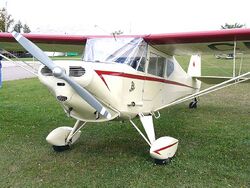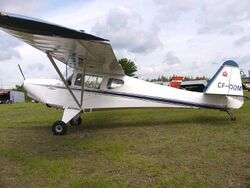Fleet Canuck
Topic: Engineering
 From HandWiki - Reading time: 3 min
From HandWiki - Reading time: 3 min
The Fleet Model 80 Canuck is a Canadian light aircraft featuring two seats in side-by-side configuration. The Canuck was designed for the flight training, personal use and light commercial roles. A total of 225 Canucks were built by two manufacturers during its thirteen-year production run, with the majority being built by Fleet Aircraft between 1945 and 1947.
Design and development
The Canuck originated with the Noury N-75, designed by Bob Noury which first flew in 1944 at Mount Hope, Ontario. The "home-built" N-75 was a conventional high-wing monoplane design with a welded-steel fuselage and tail surfaces with fabric covering, looking not unlike a Piper Cub. However, the side-by-side seating in the original design was unusual for aircraft of its time even though it was a far better arrangement for instruction. Noury also experimented with a tandem-seat arrangement on a following prototype but had only built three aircraft when he sold the Noury N-75 rights to the Fleet Aircraft Company in 1945.[1]
Fleet undertook some minor design changes, principally relocating the fuel tank, adding a skylight above the cabin, lowering the front fuselage profile and replacing the original Continental C-75 with a slightly more powerful C-85 engine. The Noury N-75 was tested in its new configuration; it first flew on 26 September 1945 with Fleet Test Pilot Tommy Williams at the controls. Following modifications to the fin to increase its size, the prototype, newly renamed, emerged as the Fleet Model 80 Canuck, and entered production.
Operational history
Although the aircraft were well built, strong performers[2] and versatile; able to be flown with floats or skis to increase its utility, after a spurt in sales, they did not sell well. In trying to market the Fleet Canuck as either a private aircraft or a trainer, there were several obstacles:
- In the immediate postwar period, surplus ex-military aircraft were cheaply available in large numbers[3]
- Ex-serviceman and civilians were more interested in careers and families than luxury items[3]
- Training aircraft were not in demand since thousands of ex-military pilots were out of work.[3]
After initial sales to flying clubs, charter companies and private owners began to falter, Fleet ran into financial problems. In 1947, Canuck production by Fleet was terminated. Over the next ten years a number of aircraft were built up from components by Leavens Brothers in Toronto with total series production finishing at 224 in 1958.[4] Several have been re-engined with the 100 hp (75 kW) Continental O-200.
In September 2010 there were 77 Canucks registered in Canada with Transport Canada.[5]
Aircraft on display
In 1995, the Royal Canadian Mint issued Coin #11, a $20 silver commemorative coin in its aviation series, recognizing the Fleet 80 Canuck and its original designer, J. Omer Noury, featured in a gold-inlay cameo insert.
- Canada Aviation and Space Museum, Ottawa, Ontario - CF-EBE, serial number 149, is in the storage building, displayed on floats.[1]
- Canadian Air and Space Museum, Toronto, Ontario - C-FEAI serial number 127.[6]
- Canadian Aviation Heritage Centre, Montreal , Quebec - CF-ENH with marking of aircraft piloted by Hubert M.Pasmore .[7]
- Reynolds-Alberta Museum, Wetaskiwin, Alberta - CF-BYW-X, the original Noury prototype, is in the storage building.[8]
Variants
- Fleet 80 Canuck : Two-seat sports and light touring aircraft.
- Fleet 81 : Three-seat light touring aircraft. One built.
Specifications
Data from Canada Aviation and Space Museum[1] & Canadian Air & Space Museum[6]
General characteristics
- Crew: one
- Capacity: one passenger
- Length: 22 ft 4 in (6.81 m)
- Wingspan: 34 ft 0 in (10.36 m)
- Height: 7 ft 1 in (2.16 m)
- Empty weight: 858 lb (389 kg)
- Gross weight: 1,480 lb (671 kg)
- Powerplant: 1 × Continental C-85-12J four cylinder horizontally-opposed aircraft engine, 85 hp (63 kW)
- Propellers: 2-bladed wooden
Performance
- Maximum speed: 111 mph (179 km/h, 96 kn)
- Cruise speed: 100 mph (160 km/h, 87 kn)
- Range: 300 mi (480 km, 260 nmi)
- Service ceiling: 12,000 ft (3,700 m)
- Rate of climb: 550 ft/min (2.8 m/s)
Similar Aircraft
References
- Notes
- ↑ 1.0 1.1 1.2 "Fleet 80 Canuck." Canada Aviation and Space Museum. Retrieved: 29 June 2017.
- ↑ Page and Cumming 1990, p. 118. Note: The Fleet Canuck was capable of aerobatics due to an airframe designed to withstand 7G maneuvers.
- ↑ 3.0 3.1 3.2 "Fleet Canuck." Collingwood Classic Aircraft Foundation, May 2002. Retrieved: 27 September 2007.
- ↑ Cite error: Invalid
<ref>tag; no text was provided for refs namedPage and Cumming 1990, p. 118 - ↑ "Civil Aircraft Register." Transport Canada, September 2010. Retrieved: 10 September 2010.
- ↑ 6.0 6.1 "Fleet 80 Canuck." Canadian Air & Space Museum, 2008. Retrieved: 10 September 2010.
- ↑ "Fleet Canuck (1947)." "Canadian Aviation Heritage Centre"
- ↑ "Aviation". Government of Alberta. https://reynoldsmuseum.ca/aviation. Retrieved 1 December 2019.
- Bibliography
- Page, Ron D. and William Cumming. Fleet: The Flying Years. Erin, Ontario: Boston Mills Press, 1990. ISBN:1-55046-019-6.
External links
 KSF
KSF




